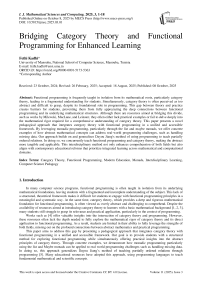Bridging Category Theory and Functional Programming for Enhanced Learning
Автор: Fethi Kadhi
Журнал: International Journal of Mathematical Sciences and Computing @ijmsc
Статья в выпуске: 3 vol.11, 2025 года.
Бесплатный доступ
Functional programming is frequently taught in isolation from its mathematical roots, particularly category theory, leading to a fragmented understanding for students. Simultaneously, category theory is often perceived as too abstract and difficult to grasp, despite its foundational role in programming. This gap between theory and practice creates barriers for students, preventing them from fully appreciating the deep connections between functional programming and its underlying mathematical structures. Although there are resources aimed at bridging this divide, such as works by Milewski, MacLane, and Leinster, they often either lack practical examples or fail to delve deeply into the mathematical rigor required for a comprehensive understanding of category theory. This paper presents a novel pedagogical approach that integrates category theory with functional programming in a unified and accessible framework. By leveraging monadic programming, particularly through the list and Maybe monads, we offer concrete examples of how abstract mathematical concepts can address real-world programming challenges, such as handling missing data. Our approach builds on and generalizes Dayou Jiang's method of using programming to teach partially ordered relations. In doing so, we concurrently teach functional programming and category theory, making the abstract more tangible and applicable. This interdisciplinary method not only enhances comprehension of both fields but also aligns with contemporary educational reforms that prioritize integrated learning across mathematical and computational domains.
Category Theory, Functional Programming, Modern Education, Monads, Interdisciplinary Learning, Computer Science Pedagogy
Короткий адрес: https://sciup.org/15020022
IDR: 15020022 | DOI: 10.5815/ijmsc.2025.03.01


